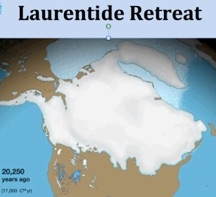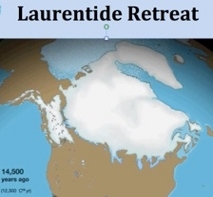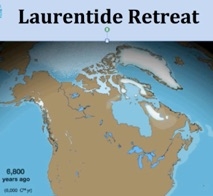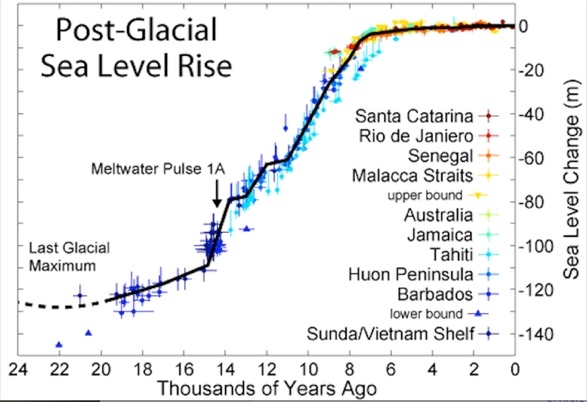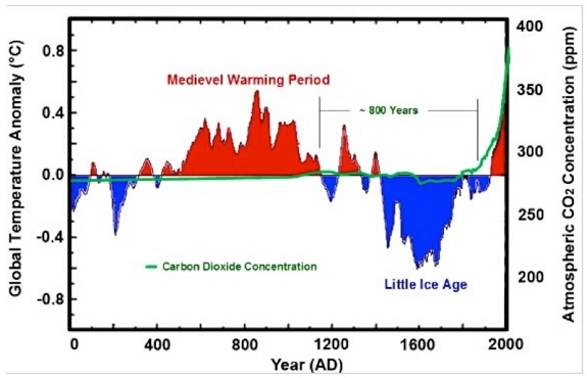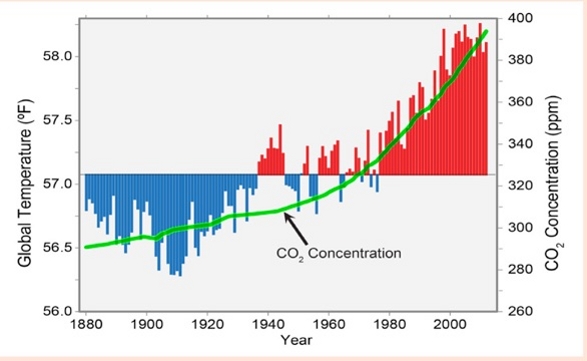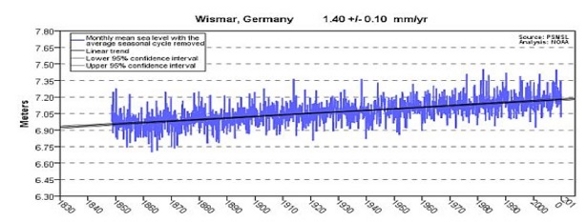|
|
The Inconvenient CO2/Sea Level Non-Linkage
25 October 2015
By Tom Wysmuller-
The Inconvenient CO2/Sea Level Non-Linkage©During the past 20,000 years, Sea Level rose as the great Ice Sheets melted. Exiting the last Ice Age, the massive (miles deep) North American Laurentide Ice Sheet disgorged megatons of water, flooding the continental shelves.
The most rapid rise was between 14,500 & 7,500 years ago. [2]
Starting 7,000 years ago, Sea Level rise levelled off and only slowly rose, mostly due to thermal expansion of oceans and edge ice melt from Greenland and Antarctica. As Earth warmed, remaining mountain glaciers also added their melt water to the oceans. When largely Northern Hemisphere land ice melted, its concentrated weight was equally distributed among all the oceans, causing uplift on formerly ice-covered land. Added water weight, deepened ocean basins, and land subsided adjacent to those basins. Actual Sea Level is measured from tectonically inert areas, neither rising nor falling. The latest 7,000 year minimal Sea Level rise was matched by CO2 readings that varied even less. A steady CO2 280 ppm continued for the same 7,000 years, apparently not affected by, or influencing some wide temperature swings. Graphics that follow cover the past 2,000 years [Temp. & CO2] and a recent 135-year subset of the same. [3]
135-year Temperature & CO2 Subset of the past 2000 years [4]
CO2 finally rises, achieving a huge 38% increase in the past 135 years, (since 1880) likely due to industrial and agricultural development. In tectonically inert areas, where land neither rises nor falls, such as Portland, Maine, and Wismar, Germany, Sea Level continues its methodical steady minimal rise. In the timeframe that CO2 massively increases, there is no sign whatsoever that Sea Level reacts likewise.
[5] With a 38% increase in CO2 you’d expect at least a 1, 5, 12, 25% (take your pick) acceleration of Sea Level. We do have minimal increases, but zero sea level rise acceleration in tectonically inert areas. Zero!!! If mankind shuts down every coal and gas fired power plant, steel mill, and every auto, plane, train and ship and if we revert to a bare bones subsistence economy, with minimal fire and combustion products, we might be able to reduce CO2 growth from its average annual increase of 1.5ppm over the Keeling Curve era (since 1958) to about 0.5ppm. When a massive 38% CO2 increase doesn’t even begin to accelerate Sea Level rise, how would we ever attempt to measure any Sea Level fall resulting from an almost impossible to achieve 1ppm reduction. The instrument that could measure that drop has yet to be invented!!! Conclusion: There is no measurable linkage between Sea Level and CO2!E-mail tom@colderside.com for info. [2] Robert A. Rohde per Fleming et al. 1998, Fleming 2000, & Milne et al. 2005 https://commons.wikimedia.org/wiki/File:Post-Glacial_Sea_Level.png [3] Adapted from Loehle, C. and McCulloch, J.H. 2008. Correction to: A 2000-year global temperature reconstruction based on non-tree ring proxies. Energy & Environment 19: 93-100. http://nipccreport.org/articles/2010/dec/22dec2010a5.html [4] National Climate Assessment (2014) Melillo, Jerry M., Terese (T.C.) Richmond, and Gary W. Yohe, Eds., 2014: Climate Change Impacts in the United States: The Third National Climate Assessment. U.S. Global Change Research Program, 841 pp. doi:10.7930/J0Z31WJ2. (Page 23) [5] British Permanent Service for Mean Sea Level http://www.psmsl.org/ & LAMPE, REINHARD; ENDTMANN, ELISABETH; JANKE, WOLFGANG; MEYER, HINRICH; LÜBKE, HARALD; HARFF, JAN; LEMKE†, WOLFRAM, 2005: A new relative sea-level curve for the Wismar Bay, N-German Baltic coast. (Eine neue relative Meeresspiegelkurve für die Wismarbucht, norddeutsche Ostseeküste).- Meyniana, 57:5-35,10 fig., 2 tab., Kiel. |



